Cruise Day 3
Speed 12 knots (kts)
Course 316° (NW)
Location Bering Sea, approx. 335 nm SW of St. Lawerence Island, 58.40° N, 175.89° W
Depth 1124 m
GO DEEPER DISCUSSION: (see previous journal for the questions.)
The map image from yesterday shows many sea-floor features surrounding us in the southern Bering Sea. Perhaps most prominent is the curving line of the Aleutian Islands- this feature is called an island arc. Below the Aleutians is a curving stripe of very deep water represented as purple that parallels the islands. This is an oceanic trench. Island arcs and oceanic trenches are found hand-in-hand at subduction zones. In this case, the Pacific tectonic plate to the south is subducting (diving under) the North American plate to the north. The Pacific plate drags down on the North American plate as it subducts, creating the trench. Once the Pacific plate reaches sufficient depth below the North American Plate it melts. Magma produced this way can melt its way up though the North American plate, emerging in a series of volcanic islands or seamounts (peaks rising from the sea floor but not reaching the surface.) There is a smaller curving line of shallower water north of the Aleutians- this is a small mid-ocean ridge. Ridges form where ocean plates are pulling apart, which allows magma to erupt onto the sea floor. Unlike island arcs, the peaks along mid-ocean ridges seldom reach sea level. Next, note the deep, flat areas that are deep blue on this map. This is a feature known as an abyssal plain. There is a steep change in depth (the contours are very close together) where the ship position is indicated. This abrupt shallowing from abyssal plain to flatter, shallower water is a continental slope. Once the depth is around 200 meters (light blue here), note that the contour lines are much farther apart, indicating a much more gradual change in depth. This sea-floor feature is called a continental shelf. Finally, there are some features that look like notches cut into the continental shelf. These are called submarine canyons.
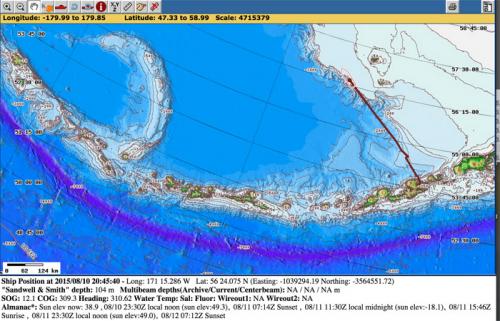 Yesterday’s map server screen capture for today’s Go Deeper discussion.
Yesterday’s map server screen capture for today’s Go Deeper discussion.
TODAY'S JOURNAL:
The day started off with a fantastic sunrise over a rolling sea.
 Bering Sea sunrise.
Bering Sea sunrise.
I’d like to follow up on yesterday’s discussion of a CTD cast, which explained the process of getting water samples from various depths up to the ship. Today, I learned more about how the GEOTRACES team gets water from the CTD to their lab space for analysis.
First of all, when the CTD is being lowered and raised, there are scientists at a console monitoring the data being returned electronically via the conducting cable and letting the winch operator know what depth the rosette is at. On the way back up, each bottle can be triggered shut at a desired depth from this console as well.
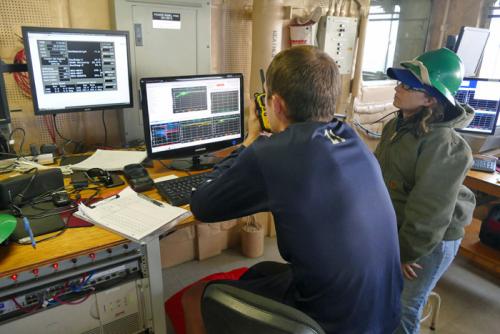 Kyle McQuiggan and Gabrielle Weiss operating the CTD data console.
Kyle McQuiggan and Gabrielle Weiss operating the CTD data console.
The next step is to safely get the now full (and thus, very heavy) CTD rosette back on deck and secured. To do this the unit is pulled out of the water via the aft A-frame crane which then tilts back over the fantail so the CTD can be lowered onto a pallet and secured to the deck.
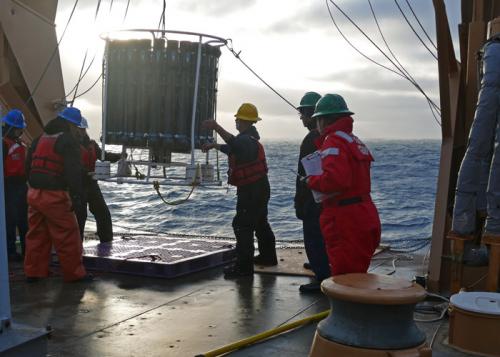 Coast Guard Crew and GEOTRACES scientists retrieving the CTD rosette after a cast.
Coast Guard Crew and GEOTRACES scientists retrieving the CTD rosette after a cast.
Once secure, the sample bottles are capped with plastic covers that look like shower caps to minimize contamination. Then, they are detached one by one from the rosette frame and carried to the GEOTRACES science van on the front end of the fantail deck.
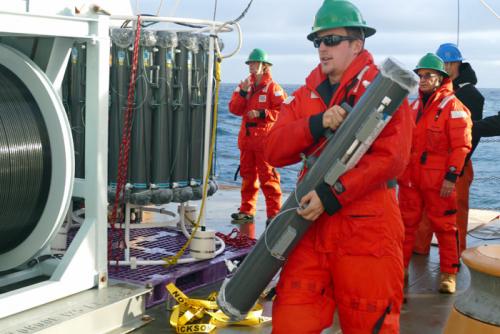 Kyle McQuiggan carries a GO FLO bottle across the fantail deck to the GEOTRACES science lab.
Kyle McQuiggan carries a GO FLO bottle across the fantail deck to the GEOTRACES science lab.
Once at the lab, the bottles are handed to scientists waiting in the clean space of the van.
 Here we see Sara Rauschenberg handing a GO FLO bottle to Peter Morton inside the science van.
Here we see Sara Rauschenberg handing a GO FLO bottle to Peter Morton inside the science van.
The lab van’s interior is kept as clean as possible, with a rule of no outside coveralls or shoes that could bring in contaminants. Air is provided through a filtration system that cleans the air and also provides positive pressure for the van, which helps to keep airborne contaminants out (much like the bubble down in the main lab.) The now-full bottles are positioned on racks lining both sides of the van. When the sampling protocol begins, the scientists can collect water from each bottle within the clean confines of the van. For even cleaner analysis in the van, there is a work station under a hood that re-filters the air entering the device. It works a bit like a fume hood in reverse, so air comes in through the top, gets filtered, and flows out the bottom.
 The GEOTRACES Van has an air filtration system to provide clean air and positive pressure in the lab environment.
The GEOTRACES Van has an air filtration system to provide clean air and positive pressure in the lab environment.
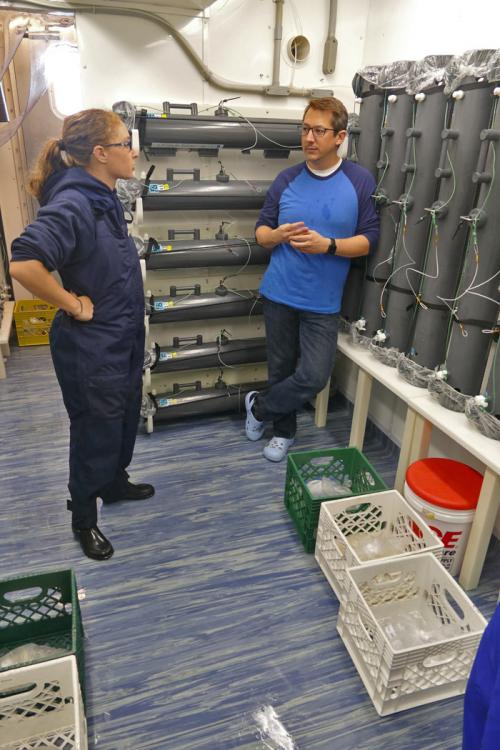 Gabrielle Weiss and Peter Morton discussing the steps needed to cleanly recover water samples from the GO FLO bottles racked on the side walls of the GEOTRACES van.
Gabrielle Weiss and Peter Morton discussing the steps needed to cleanly recover water samples from the GO FLO bottles racked on the side walls of the GEOTRACES van.
GO DEEPER!
After breakfast today the Sun broke through the clouds. For a while, beams of sunlight radiated out from the clouds in a beautiful display. Do you know what this atmospheric phenomenon is called? If not, try an online search to find out.
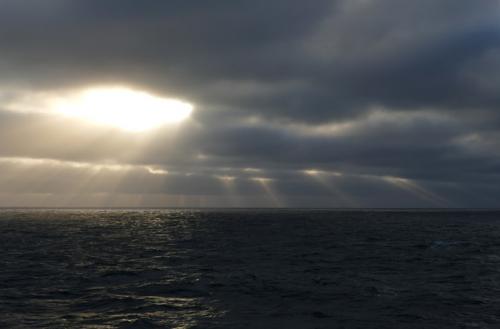 Beams of light appear to fan out below the clouds this morning in the Bering Sea.
Beams of light appear to fan out below the clouds this morning in the Bering Sea.
Aloft Con web cam updated every hour
Healy Track
That's all for now. Best- Bill

